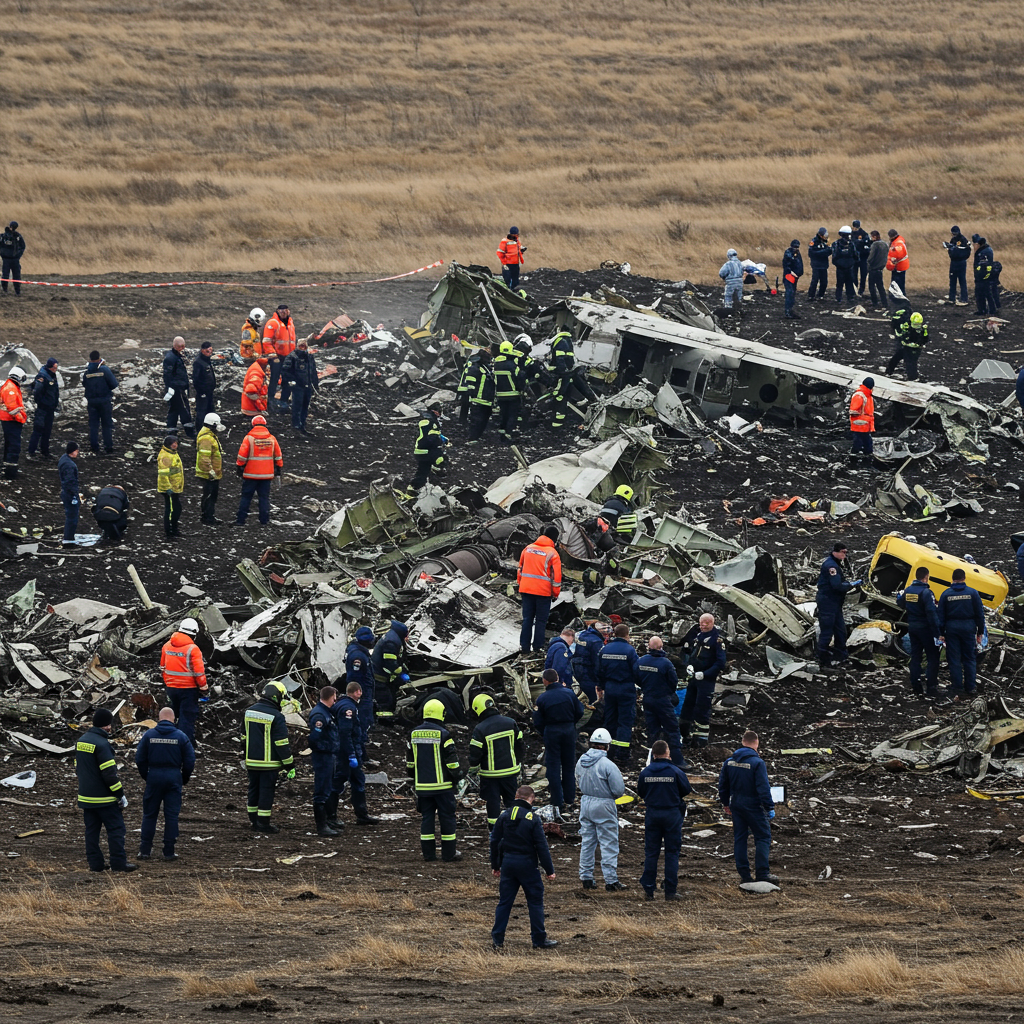The aviation world was shaken on Thursday, July 24, 2025, when a Russian passenger plane crash in the country’s far eastern Amur region resulted in the tragic loss of all 48 individuals on board. The An-24 aircraft, operated by Siberia-based Angara Airlines, vanished from radar during its approach to Tynda, a remote town and crucial railway junction near the Chinese border. This devastating incident has cast a stark light on the challenges facing Russia’s aging aviation fleet and the broader implications of international sanctions on its air safety.
The plane, which had departed from Blagoveshchensk, a regional hub approximately 360 miles away, was undertaking a journey to Tynda when communication was abruptly lost. Initial reports varied slightly on the number of people aboard, but officials swiftly confirmed 48 fatalities, encompassing both passengers and crew members. The scale of the tragedy prompted Governor Vasily Orlov of the Amur region to declare three days of official mourning, a poignant testament to the profound grief gripping the community.
The Catastrophic Incident Unfolds
The An-24’s flight path began in Khabarovsk, included a stop in Blagoveshchensk, and was en route to Tynda when the disaster struck. According to reports from the transport prosecutor’s office in the Far East, the aircraft was attempting its second approach for landing when it lost contact with air traffic control and disappeared from radar screens. This critical detail suggests a potential struggle with landing conditions or technical issues in the moments leading up to the crash.
Emergency services rapidly launched a search operation. A search and rescue helicopter from Russia’s federal aviation agency, Rosaviatsiya, was pivotal in the discovery. It located a burning fuselage in a densely forested, hilly area, approximately nine miles (15 kilometers) south of Tynda. The remote and rugged terrain of the crash site significantly complicated access for rescuers, with images from Russian state media later depicting debris scattered across the dense woodland, shrouded by plumes of smoke. More than 50 personnel and 10 pieces of equipment were deployed in the arduous recovery efforts.
Official Response and Initial Findings
Following the grim discovery, official statements quickly confirmed the complete loss of life. Governor Orlov expressed deep regret on Telegram, confirming that rescuers had reached the crash site and there were no survivors. Artem Korenyako, a spokesperson for Rosaviatsiya, and the Russian Ministry of Emergency Situations also utilized Telegram to disseminate updates, confirming the finding of burning wreckage and the extensive search and rescue deployment.
As the immediate aftermath unfolded, Igor Kobzev, the Governor of Irkutsk Oblast, provided further details regarding the victims. He confirmed that the flight crew, technical staff, and flight attendants were residents of the Irkutsk region. Officials immediately began working to compile a full list of passengers, with efforts to identify those from the Irkutsk area. Among the casualties, it was later confirmed that at least one Chinese national was aboard the ill-fated flight, highlighting the international dimension of the tragedy.
Investigating the Causes: Age, Weather, and Sanctions
Authorities promptly launched a probe into the crash, investigating potential flight safety violations leading to multiple deaths – a standard procedure in aviation accidents of this magnitude. While the precise cause is under investigation, several contributing factors have emerged from preliminary reports and expert analyses.
One significant factor highlighted by Russian news outlets is the advanced age of the aircraft. The An-24 was a Soviet-era model, built in 1976, making it nearly 50 years old at the time of the crash. Its tail number indicated it had previously been operated by the Soviet flag carrier Aeroflot before 1991. The average age of Russia’s domestic fleet is a growing concern, particularly as international sanctions have constrained the country’s access to modern aircraft and essential maintenance parts.
The Broader Context of Russian Aviation Safety
The Amur region plane crash is not an isolated incident but rather fits into a broader pattern of aviation safety challenges in Russia. Flying in Russia’s vast and often extreme hinterlands, including the Arctic and Far East, can be inherently challenging due to severe weather conditions. Indeed, unnamed emergency services sources cited by Interfax reported adverse weather conditions at the time of the crash, suggesting poor visibility or other atmospheric factors may have played a role in the aircraft’s attempt at a second landing.
The incident underscores the increasing strain on Russia’s aviation sector, largely attributed to international sanctions imposed following recent geopolitical events. These sanctions have significantly impacted investment in the sector and restricted access to crucial Western-made parts and maintenance expertise. Many older, Soviet-era aircraft, like the An-24, were originally scheduled for retirement. However, regional airlines are now striving to keep them in service due to a lack of immediate modern alternatives. The mass production of the new Ladoga aircraft, intended as a replacement for the An-24 class, is not anticipated until 2027 at the earliest, further exacerbating the reliance on an aging fleet.
While the propeller-driven An-24s are often affectionately called “flying tractors” for their robust design and reliability in harsh climates, capable of operating in sub-zero conditions and on unpaved runways, their maintenance costs have surged under the weight of sanctions. This tragic Russian plane crash serves as a stark reminder of the complex interplay between geopolitical pressures, economic realities, and aviation safety standards in the country. The ongoing investigation aims to determine the exact sequence of events and factors that led to this devastating loss of life.
Frequently Asked Questions
What happened in the An-24 Russian plane crash on July 24, 2025?
On Thursday, July 24, 2025, an Angara Airlines An-24 passenger plane, carrying 48 people, crashed in Russia’s far eastern Amur region. The aircraft, nearly 50 years old, disappeared from radar during its approach to Tynda, having departed from Blagoveshchensk. All 48 individuals on board perished in the incident. Wreckage, including a burning fuselage, was located in a densely wooded area approximately nine miles from Tynda. The local governor declared three days of mourning in response to the tragedy.
What factors are believed to have contributed to the tragic crash?
Several factors are under investigation as potential contributors to the Russian An-24 crash. Preliminary reports suggest that the aircraft was attempting a second landing when it lost contact with air traffic control, possibly amid adverse weather conditions and poor visibility. A significant contributing factor also highlighted is the aircraft’s age; the An-24 was nearly 50 years old. Furthermore, experts point to the broader context of international sanctions impacting Russia’s aviation sector, straining maintenance capabilities and hindering access to modern replacement aircraft, forcing reliance on older models.
How has the Russian aviation sector been impacted by recent events, as highlighted by this incident?
The July 2025 Russian plane crash underscores the increasing pressure on Russia’s aviation sector. International sanctions have severely limited access to foreign-made aircraft and crucial spare parts, leading to a greater reliance on an aging fleet of Soviet-era planes like the An-24. While these older aircraft are known for their ruggedness, maintaining them has become significantly more challenging and costly. The lack of immediate modern alternatives, with new aircraft types not expected until 2027 or later, means older planes are being kept in service longer than initially planned, raising concerns about long-term aviation safety in the region.
The full investigation into the Amur region plane crash continues, seeking to provide definitive answers and to prevent future tragedies. The incident is a sobering reminder of the constant need for stringent safety protocols and robust infrastructure in air travel, especially in challenging operational environments.




